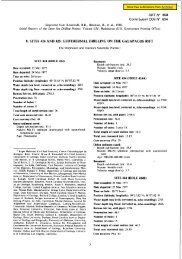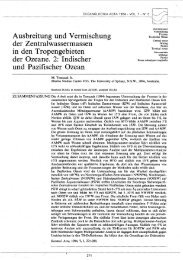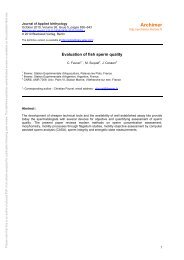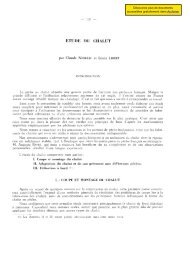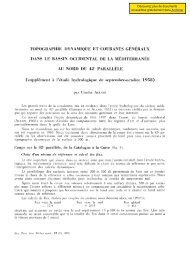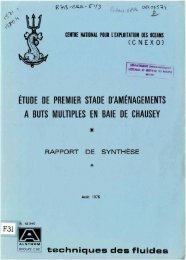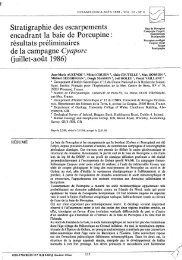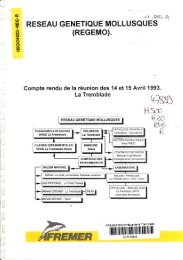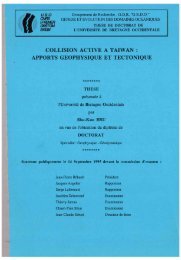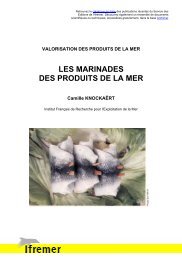Approche quantitative de la fonction de nourricerie jouée par les ...
Approche quantitative de la fonction de nourricerie jouée par les ...
Approche quantitative de la fonction de nourricerie jouée par les ...
Create successful ePaper yourself
Turn your PDF publications into a flip-book with our unique Google optimized e-Paper software.
Chapitre 4 : Impact of vegetation structure dynamics and usage on the nursery function<br />
of West European tidal salt-marshes.<br />
1. Abstract.<br />
An analysis of the fish community of Aiguillon bay (France) and Mont Saint-Michel<br />
bay was performed in or<strong>de</strong>r to i<strong>de</strong>ntify the fish settler guild structure. Some species settled in<br />
salt marshes only in their first years when they were young-of-the-year or juveni<strong>les</strong> (YoY salt<br />
marsh settlers and juvenile salt marsh settlers). Others fish species were resi<strong>de</strong>nt salt marsh<br />
settlers like gobies (Pomatoschistus spp.) that conduct all their life cycle in this ecosystem.<br />
Another settler guild is composed of species that show opportunistic settler behaviour. These<br />
species forage in the salt marsh at either young or adult stages (opportunistic salt marsh<br />
settlers). Management for bird conservation leads to modifications in vegetation structure.<br />
The halophytic community is mowed every year during spring and autumn to create<br />
favourable habitats for Anatidae and wa<strong>de</strong>r conservation. This management seems to have<br />
adverse effects on the nursery role for fish popu<strong>la</strong>tions such as Seabass. A com<strong>par</strong>ison<br />
between the nursery role of Aiguillon bay and Mont Saint-Michel Bay showed significant<br />
differences. The first bay sustains preferentially young-of-the-year of pe<strong>la</strong>gic species. The<br />
Aiguillon bay sustains many YoY species (Seabass, European anchovy and Clupeidae YoY).<br />
The key nursery role often <strong>de</strong>scribed seems to be disturbed in Mont Saint-Michel bay. Low<br />
juvenile abundances were observed. Sheep grazing impact and invasion by the grass<br />
Elytrigia atherica seems to have modified the initial nursery function of these coastal zones.<br />
Keywords: fish community, nursery function, estuarine systems, settlers guilds,<br />
Aiguillon bay, Mont Saint-Michel bay.<br />
Mots clés : communauté piscicole, <strong>fonction</strong> <strong>de</strong> <strong>nourricerie</strong>, systèmes estuariens,<br />
guil<strong>de</strong>s colonisatrices, baie <strong>de</strong> l’Aiguillon, baie du Mont Saint-Michel.<br />
2. Introduction.<br />
The ecosystem complexes formed by European intertidal mudf<strong>la</strong>ts and salt marshes<br />
p<strong>la</strong>y an important nursery role for many species of fish (Riou 1999a; Laffaille et al. 2000a;<br />
Le Pape et al. 2000; Lefeuvre et al. 2000). Most of these species have the capacity to<br />
withstand <strong>la</strong>rge variations in salinity (Elie et al. 1990). They can therefore take advantage of<br />
the high production of organic matter on these coastal mudf<strong>la</strong>ts (Christensen et Pauly 1998;<br />
Laffaille et al. 2002) or on their adjacent saltmarshes (Laffaille et al. 1998). Some of these<br />
species have an economic fisheries interest and also <strong>par</strong>ticipate actively in transfers of<br />
organic matter between the tidal marshes and adjacent coastal systems (role of biotic vector).<br />
120



